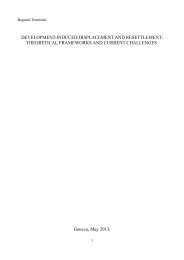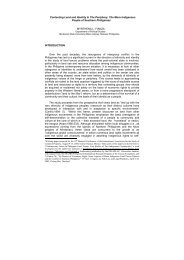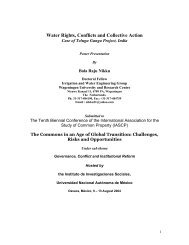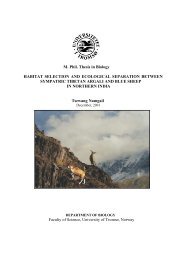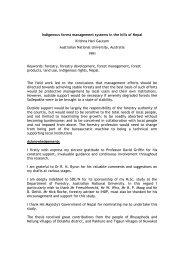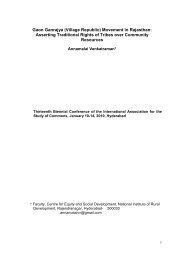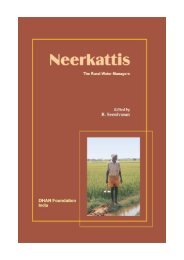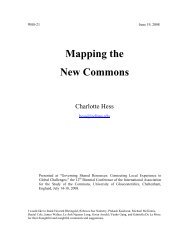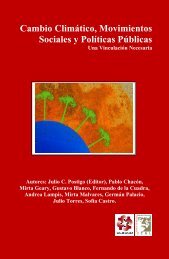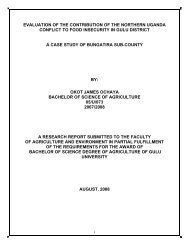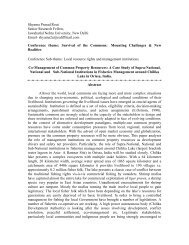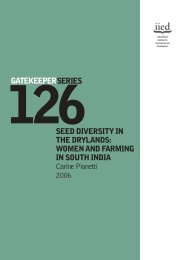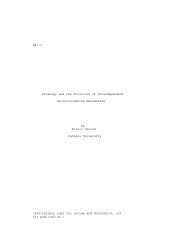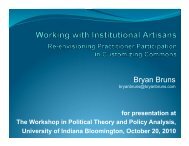Occupying the Land - Digital Library Of The Commons
Occupying the Land - Digital Library Of The Commons
Occupying the Land - Digital Library Of The Commons
Create successful ePaper yourself
Turn your PDF publications into a flip-book with our unique Google optimized e-Paper software.
email to Nives Dolsak and Elinor Ostrom, co-chairs at Indiana U cc. "Fikret Berkes" IASCP 2000 Conference,ABSTRACT<strong>Occupying</strong> <strong>the</strong> <strong>Land</strong>: Traditional Patterns of <strong>Land</strong> and Resource Ownership amongFirst Peoples of British ColumbiaNancy J. Turner and James T. JonesSchool of Environmental Studies, University of Victoria,Victoria, British Columbia V8W 2Y2 Canadaphone (250) 721-6124; FAX (250) 721-8985; email: A frequent misconception of early European settlers in what is now British Columbia wasthat <strong>the</strong> Aboriginal inhabitants were not really using most of <strong>the</strong> land, did not reallyoccupy very much of it, and held no real concepts of ownership for ei<strong>the</strong>r <strong>the</strong> land or itsresources. This perspective was encouraged among <strong>the</strong> newcomers, who o<strong>the</strong>rwise mighthave had to restrict <strong>the</strong>ir own desired occupation of <strong>the</strong> land and conform to existingcodes of ownership.In fact, First Peoples throughout <strong>the</strong> region had well developed concepts of territory,occupancy and proprietorship over lands and resources with firmly embedded protocolsfor resource use and distribution within and among families and communities. <strong>The</strong>seconcepts varied from one cultural group to ano<strong>the</strong>r, and access to some areas and primeresources, such as salmon streams and important root ga<strong>the</strong>ring and berry picking areas,were more closely controlled than o<strong>the</strong>rs. In all cases, however, traditional proprietorshipwas inextricably linked with responsibilities of <strong>the</strong> owners for stewardship and sharing ofresources.We provide examples of different cultural models of land and resource ownership,ranging from communal control of territory at <strong>the</strong> tribal level for Salishan peoples, tomore specifically focussed hereditary ownership and control of lands by clan chiefs, aspracticed by <strong>the</strong> Nuu-Chah-Nulth, Kwakwaka’wakw, Haida, Nisga’a and o<strong>the</strong>r NorthwestCoast peoples. <strong>The</strong> implications of <strong>the</strong>se systems of ownership for resource sustainabilityare also discussed. <strong>The</strong> systems have been largely disrupted from <strong>the</strong> imposition ofEuropean law and property systems, but <strong>the</strong>y still exist, and with new arrangements forland tenure deriving from Treaty Negotiations, <strong>the</strong>y may be reinstated to some extent in<strong>the</strong> coming years. <strong>The</strong>re is a good potential for improving contemporary resourcemanagement through incorporation of some of <strong>the</strong>se traditional models of land tenure anduse.30



